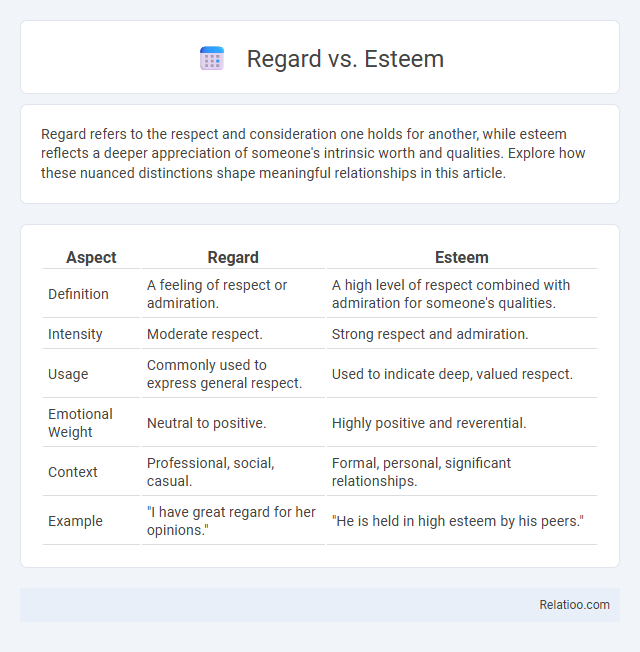Regard refers to the respect and consideration one holds for another, while esteem reflects a deeper appreciation of someone's intrinsic worth and qualities. Explore how these nuanced distinctions shape meaningful relationships in this article.
Table of Comparison
| Aspect | Regard | Esteem |
|---|---|---|
| Definition | A feeling of respect or admiration. | A high level of respect combined with admiration for someone's qualities. |
| Intensity | Moderate respect. | Strong respect and admiration. |
| Usage | Commonly used to express general respect. | Used to indicate deep, valued respect. |
| Emotional Weight | Neutral to positive. | Highly positive and reverential. |
| Context | Professional, social, casual. | Formal, personal, significant relationships. |
| Example | "I have great regard for her opinions." | "He is held in high esteem by his peers." |
Introduction to Regard and Esteem
Regard and esteem both convey respect and admiration but differ in intensity and formality. Regard often implies a general feeling of respect or consideration, while esteem denotes a higher level of admiration and value placed on someone's qualities or achievements. Understanding these nuances helps you communicate appreciation more precisely in personal or professional contexts.
Defining Regard: Meaning and Usage
Regard refers to the attention or consideration you give someone or something, often implying respect or admiration in various contexts. It denotes a thoughtful acknowledgment or evaluation, distinguishing it from esteem, which conveys a higher level of admiration or value. Understanding the subtle nuances of regard enhances your ability to express respect and appreciation effectively in communication.
What is Esteem? Semantic Implications
Esteem refers to the respect and admiration you hold for someone based on their qualities, achievements, or character. It carries a deeper emotional value than regard, implying a positive judgment and high valuation of the individual. Understanding the semantic implications of esteem helps differentiate it from regard, which is more neutral, and respect, which emphasizes recognition of status or rights.
Historical Contexts of Regard and Esteem
Regard and esteem have evolved through centuries with distinct historical connotations, where "regard" originally emphasized observation and attention in medieval texts, while "esteem" emerged from Latin roots signifying valuation and respect in Renaissance humanism. Historical contexts show that regard often denoted a general sense of acknowledgment or consideration, whereas esteem typically implied a higher degree of admiration based on moral or intellectual qualities. The nuanced usage differences reflect societal shifts in valuing personal character and social honor in Western philosophical and literary traditions.
Key Differences Between Regard and Esteem
Regard refers to the respect or consideration one holds for someone or something, often based on general perception or feelings. Esteem implies a higher level of admiration rooted in recognizing someone's qualities, achievements, or intrinsic worth. The key difference lies in esteem being more evaluative and deeply appreciative, while regard encompasses a broader range of respectful attitudes.
Usage of Regard vs Esteem in Modern English
Regard and esteem both express respect or admiration but differ in formality and intensity; regard is more neutral and versatile in modern English, often used in everyday contexts such as "He has high regard for her opinions." Esteem conveys deeper respect and admiration, typically reserved for formal or serious contexts like "She is held in great esteem by her colleagues." Usage trends show regard appears more frequently in casual speech and writing, while esteem maintains a tone of elevated recognition or honor.
Examples in Sentences
Regard, esteem, and respect all relate to positive feelings toward someone but differ in nuance and use. You might say, "I regard her as a skilled professional," to indicate recognition, while "He is held in high esteem by his peers" highlights admiration and value. Respect is commonly used in contexts like, "You must respect your elders," emphasizing honoring and treating someone with consideration.
Psychological Perspectives on Regard and Esteem
In psychological perspectives, regard refers to the basic acknowledgment and positive recognition of an individual's worth, often tied to social acceptance and interpersonal validation. Esteem goes deeper, involving a complex evaluation of self-worth influenced by internal beliefs and external feedback, playing a crucial role in self-concept and motivation. High levels of both regard and esteem are essential for healthy self-esteem, which impacts mental health, resilience, and social functioning.
Cultural Variations: How Regard and Esteem Differ Globally
Regard and esteem vary significantly across cultures, influencing how respect and value are demonstrated and perceived worldwide. In collectivist societies, regard often emphasizes group harmony and social roles, while esteem may prioritize individual achievements and personal merit in more individualistic cultures. Understanding these nuances helps you navigate respect and recognition appropriately in global contexts.
Choosing the Right Term: Contextual Guidelines
Choosing the right term between regard, esteem, and respect depends on the context and intensity of admiration. Regard refers to general consideration or attention, esteem implies a higher level of admiration often linked to value or worth, and respect encompasses recognition of qualities, rights, or status. Use regard for neutral acknowledgment, esteem for valued admiration, and respect for honoring or recognizing authority and dignity.

Infographic: Regard vs Esteem
 relatioo.com
relatioo.com